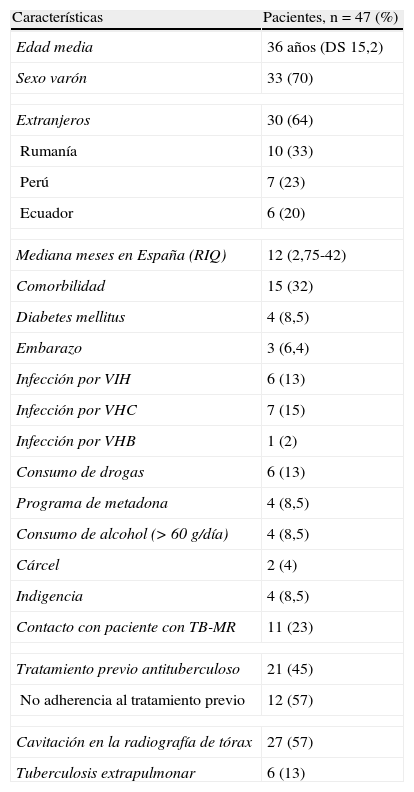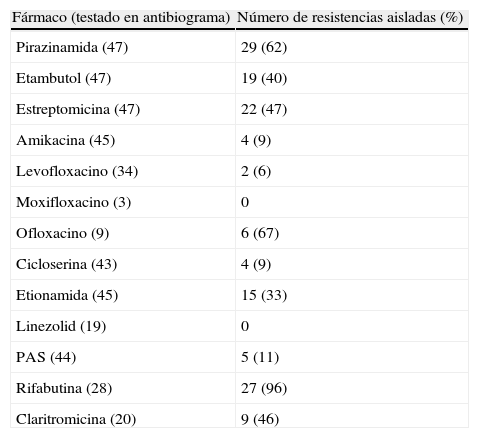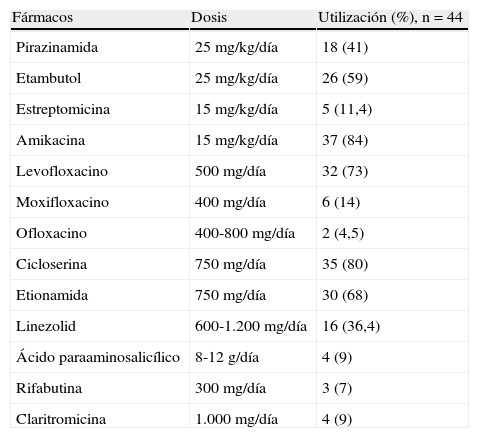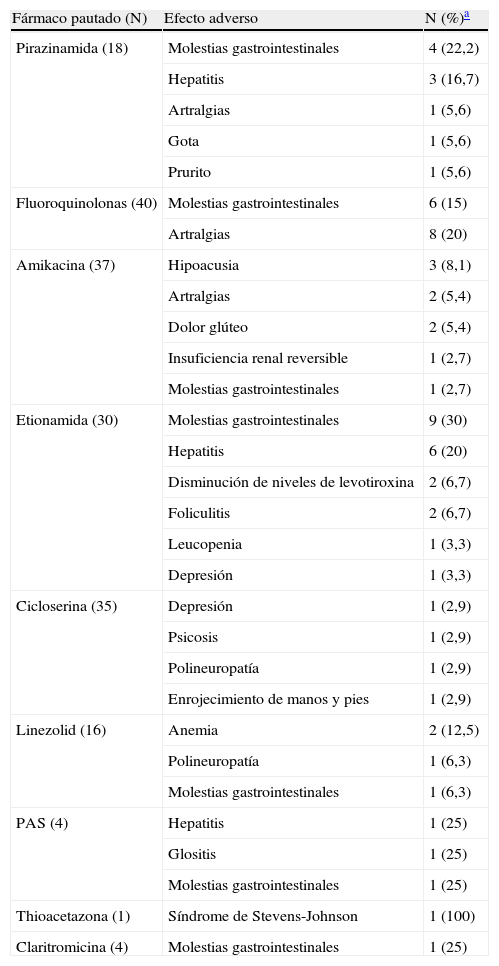A pesar de los avances en reducir la incidencia de la tuberculosis, la emergencia de la tuberculosis multirresistente durante las últimas décadas amenaza con limitar estos resultados. El objetivo de este estudio es evaluar las características epidemiológicas, clínicas y microbiológicas y los resultados del tratamiento de una serie española de pacientes con tuberculosis multirresistente.
Pacientes y métodoEstudio retrospectivo realizado entre enero de 1998 y diciembre de 2010 en la Unidad de Aislamiento de Medicina Interna del Hospital de Cantoblanco-La Paz de Madrid.
ResultadosUn total de 47 pacientes fueron evaluados. La edad media fue de 36 años y 33 eran varones. Un 64% eran extranjeros. Hubo 26 casos nuevos (55,3%). Los pacientes fueron resistentes a 5 fármacos de mediana y 3 cumplieron criterios de tuberculosis extremadamente resistente. La mediana de tiempo hasta la negativización del cultivo fue de 68,5 días (rango intercuartil [RIQ] 49,5-91,8) y la de hospitalización 2,75 meses (RIQ 1,3-4,6). Los pacientes recibieron tratamiento durante 22,4 meses de mediana (RIQ 15,3-24,3). Se obtuvo respuesta favorable al tratamiento en el 93%. Se realizó tratamiento directamente observado en el 79%. El 68% presentaron algún efecto adverso, que fueron leves o moderados en el 75%. Se pudo realizar seguimiento tras la finalización del tratamiento en 14 pacientes, con una mediana de 40,5 meses (RIQ 7,4-55), y no se objetivó ninguna recidiva clínica ni microbiológica.
ConclusiónLa mayoría de los pacientes con tuberculosis multirresistente pueden alcanzar la curación con el uso de pautas de tratamiento adecuadas, un control exhaustivo de los efectos adversos y la aplicación de estrategias para mejorar la adherencia al tratamiento.
Although progress has been made to reduce the global incidence of tuberculosis, the emergence of multidrug-resistant tuberculosis during the past decade threatens to limit these results. The aim of this study is to evaluate the geographic distribution, clinical and microbiological characteristics and outcomes of multidrug-resistant tuberculosis patients in Spain.
Patients and methodsRetrospective study between January 1998 and December 2010 of patients attended in Cantoblanco-La Paz Hospital Isolation Internal Medicine Unit.
ResultsForty-seven patients were studied, with a mean age of 36 years. There were 33 male. Sixty-four per cent were immigrants and the mean residence time in Spain was 12 months. Twenty-six patients (55.3%) were new cases. Patients were resistant to a median of 5 drugs (interquartile range [IQR] 3-7) and 3 patients had extensively drug-resistant tuberculosis. Cultures became negative after a median of 68.5 days (IQR 49.5-91.8). The median length of hospitalization was 2.75 months (IQR 1.3-4.6). They were treated during a median of 22.4 months (IQR 15.3-24.3). The overall success rate was 93%. A directly observed treatment was carried out in 79% of patients. Sixty-eight per cent patients presented side effects. In 75% of the cases the effects were mild and moderate with no need to replace the drug. Fourteen patients were followed up for a median of 40.5 months (IQR 7.4-55) and no clinical or bacteriological manifestation of disease was detected.
ConclusionsMost patients with multidrug-resistant tuberculosis can be cured with the use of appropriate and intensive regimens, management of side effects and implementation of strategies to improve adherence to treatment.
Artículo
Comprando el artículo el PDF del mismo podrá ser descargado
Precio 19,34 €
Comprar ahora












